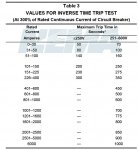Where do you get that 20% from? AB-4 has tollerances for magnetic elements and they are +40% -30% (for lowest setting, -25% for all other settings on adjustable). And if you are using the pulse method you are supposed to subtract another 5% off the low end.
As a person who is in the field whatever it is really is of no consequence when you a faced with an instantaneous rise in current it will trip the breaker no matter.
With the smallest breakers the calibration range is more likely in the area that you suggest which is an amazingly great range and with the commercial/industrial breakers they could be -20% to +10%.
The fact remains that there is a magnetic element that trips the breaker when it's subjected to a fault, which the max calibration is set to protect the breaker such that it is below the breaker's SCCR such that the breaker is not damaged.
The point being that the magnetic trip values is really mute point. The breaker must protect itself and with adjustable trips you can try to coordinate breakers by setting one lower than an upstream breaker. But there is no guarantee in doing that because often time a short circuit can be of a high enough magnitude that both breakers will see it and it will be a race to see which one trips first. How many time to you have a fault in a branch circuit protected by a 20a breaker and you trip the 100a main?
And with the mag. only MCP its intent is to detect motor failure by trip should there be an arcing fault within the motor. The objective is to limit motor damage as a motor begins to fail. As such the MCP had a different purpose that the standard TM breaker where the mag element is looking to keep the breaker from being destroyed.


